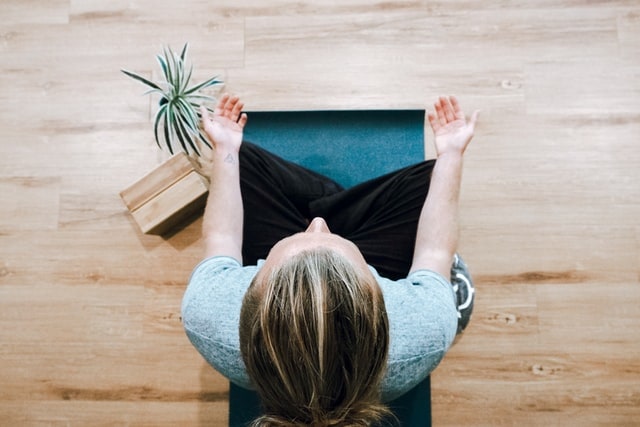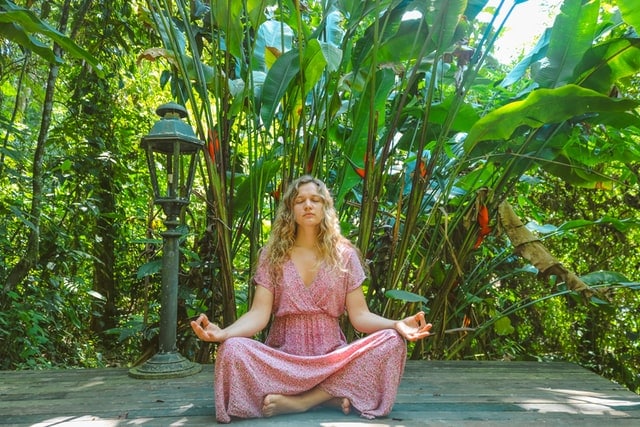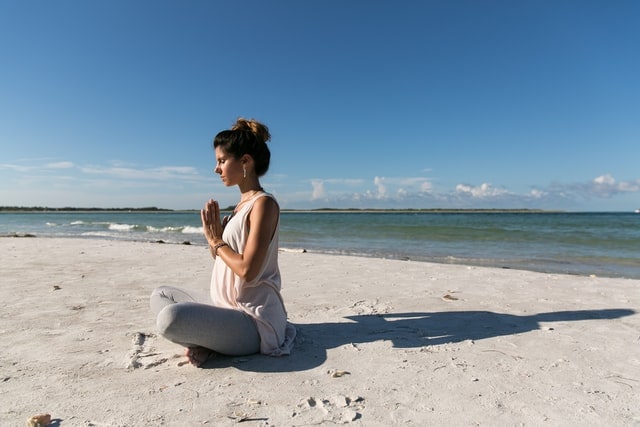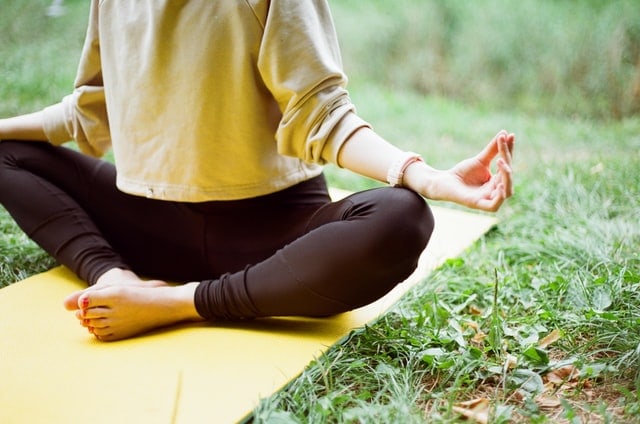tStarting a meditation habit can sound intimidating to anyone, but what if we told you that healing meditation can be a simple, gentle practice that you can do anytime, anywhere? And that you’ll finish your session feeling calmer and happier? And that the feeling will last all day?
Sounds like a win-win to us!

The top 3 benefits of healing meditation
Although meditating may take a bit of practice, it comes with so many benefits that it’s worth trying. Regular meditation reduces anxiety, improves focus, and boosts memory and creativity. But don’t take it from us – listen to what the scientists and researchers are saying!
1. It makes you happier and less anxious
A study conducted by Harvard-affiliated Massachusetts General Hospital (MGH) found that meditation makes positive changes to your neural network. In other words, it rewires your brain to experience less anxiety and give more mental space to focus on what you can control.
2. It puts you in control of your brain
Yale University found that people who meditate can help you reduce your mind wandering. This ability to control your thoughts keeps you from staying stuck in the past and to stay present in the moment.
3. It makes you physically fitter
Everyone knows that stress or depression for prolonged periods is bad for you, but Translatational Psychiatry found that depression can severely impact your health. For example, high blood pressure, a weak immune system, frequent headaches, and niggling aches and pains – all can be traced back to stress. With meditation, you’ll reap the benefits of lowered stress levels, healthy ageing, and increased serotonin (the happy hormone) levels over time.

Different types of healing meditation
No matter what your preferences are, there’s a type of meditation for you. Browse through this list and find the one for you!
Mindfulness meditation
This form teaches you how to meditate by understanding mindfulness. Helping you become more present so that you can be aware of your mental and emotional processes. This helps you recognize signs that you may need to resolve issues, slow down, or improve certain areas of your life. If you tend to rush through life without introspection or feel anxious or restless when alone, mindfulness can be a healing meditation process that will help you become more comfortable with yourself.
Isha Kriya meditation
Isha Kriya meditation is helpful for those who find it hard to sit still and clear the mind. This form of healing meditation is designed to include physical postures like in yoga. It offers the added benefits of flexible muscles and gentle exercises to boost circulation and digestion.
Yoga nidra meditation

Yoga Nidra is an effective healing meditation that takes you through the stages of consciousness to a deeper state like sleep. It is during this deep state that you repeat affirmations so that they become imprinted on your consciousness. It is not easy to do this on your own, especially if you’re a beginner, so this is best done as a guided meditation with an experienced instructor.
Guided meditation
This form of guided meditation or healing meditation is best suited for beginners or those with restless minds. It is a simple practice that requires you to listen and follow instructions. You can do this in person with an instructor or use one of the many apps or videos available online.
Kundalini meditation
Kundalini in Sanskrit means ‘coiled snake’ and it represents the divine energy or potential that lies within each of us. This form of mindfulness teaches us how to meditate to unlock our potential. There is also a version of Kundalini yoga that you can do together but you can do them separately too. Kundalini meditation involves exercising our focus and attention and can help resolve deep mental or emotional anguish.
Chakra meditation
When you first learn how to meditate with chakra meditation, you may find it challenging to achieve the intense focus it requires. According to the principles of this form, there are seven centres of energy in the body where energy wheels are located. These wheels represent different levels in the spiritual world and the physical world, and any blockages may be linked to something that is happening in your life or in your thoughts.

There are many other forms of meditation too but for beginners, this list should be enough to choose from as a start. At the end of the day, all forms teach you how to meditate and channel your energies and focus towards positive healing.
How to use healing meditation for a happier, more productive life
When you start meditating, you’ll see some almost-immediate differences. You’ll notice that you’re calmer and more focused in your daily life. We all experience some stress or anxiety daily, but mediation can help you feel less anxious or better able to handle your worries.
Meditation teaches you how to focus and gives you the self-awareness to prioritise important tasks, which can be an immense help in the workspace. It also puts you in touch with your feelings and helps you moderate your reactions, both of which are important in any relationship, whether professional or personal.
No matter which form of healing meditation you choose, here are some things that will help you achieve better results.
Aim for a regular practice
Learning how to meditate can take time and practice. When you start, you may find it hard on some days (or even every day) to focus on emptying your mind of distractions. But don’t allow this to deter you from showing up every day and trying.
Be patient
No form of healing meditation is a quick fix. Whether you aim to be calmer, more aware, how to control anger, or just want to be able to spend some quiet time with your thoughts, meditation takes time. For many beginners, it is not easy to observe the benefits even if they are already taking place, simply because the skill of self-observation has not been fully formed.
Keep an open mind

Approaching meditation with an open mind allows you to be receptive of the changes and the ideas that are offered to you. Spend some time looking for the form of meditation that resonates with you and pursue it. You do not have to be spiritual or religious to develop a habit of meditation and enjoy the benefits.
Be observant
For some people, it helps to track progress or have a record of growth through the meditation process. You might like to maintain a journal in which you write down what ideas or changes you notice during your practice. You may also like to spend a few minutes before and after each session to take stock of what your emotional and mental state is. Even if you notice you’re sleeping better or choosing healthy snacks on the days you’ve meditated, that’s a significant benefit. Knowing that you’re doing something good for yourself will encourage you to maintain a practice.
Make healing meditation a part of your life
Just like a regular running or workout habit makes you more aware of the fuel you put into your body, a regular meditation practice will teach you to look after yourself and your mental health. If you place the idea of wellbeing at the centre of your life, you’re more likely to avoid toxic situations, be kind to yourself, and become a better person to those you love.
How to start your healing meditation practice
Meditation is not about religion, but many people find that it brings spiritual peace. Some people just feel more grounded and focused during the day, and for some, it helps heal and process emotions so that you feel mentally more stable.
Whatever your reasons for beginning meditation, it’s very important that you make time for your health and emotional wellbeing, and a healing meditation practice is a great place to start.

Set a routine for meditation
It might take some getting used to, but you should have a fixed time for meditation. For most people, the early hours of the morning work best, because that is when your mind is least distracted and tired. A simple guided morning meditation helps you to start your day with a feeling of focus and purpose. Meditation is as much about disciplining your mind as it is about finding peace, so learning to maintain a routine is a good start.
Find a quiet spot for yourself
Most of us don’t have a separate room or a home gym in which we can practice meditation, but you can always use a guest bedroom, a living room, a garden, or even the bedroom for your session. If you’re the kind of person to be bothered by clutter, make sure you do a quick clean-up before you start your meditation, or that will be the only thing you think about.
Find your comfort level
You do not have to sit cross-legged or adopt the lotus pose if this is not comfortable for you, so decide on a position that works for you. If you want, you can even sit in a chair with a comfortable backrest, or sit on the floor and lean against a wall with your legs stretched out in front of you.
Set an achievable goal
Start off with a goal of meditating for 10 or 15 minutes. It might not seem like a lot, but trying to harness your mind takes some effort, and you want to have an achievable goal.
Go with the flow
You start your healing meditation by focusing on your breathing. This is the easiest way to train your mind to focus on something. Breathe in normally through your nose, imagine fresh air coursing through your nostrils, past your tonsils and the back of your throat, and down into your lungs. Fill your lungs slowly, imagining all that healing oxygen rushing through your body, especially to the parts that ache. Slowly exhale through your mouth.
Don’t stress about distractions
It is fine to hear (and be distracted by) the honking of vehicles, the sounds of your neighbour waking up, the sounds of your own family. Being present is part of the process. Notice the sounds and acknowledge them, but don’t spend time chasing the thought. For example: If you hear your dog barking outside, acknowledge that you heard the sound, but move on to focus on the next sound. Don’t start reminding yourself that you really need to pick up doggy treats today.
Space it out
During mindfulness meditation, every move should be purposeful and paced – don’t rush to breathe out, don’t force yourself to hold your breath, and be gentle when you exhale and inhale. At the end of your session, remember to stretch your spine and limbs, drink some water, and then rise slowly from your position. You’re all set for a great day!
It helps to have a few aids: a yoga mat, a bottle of water close at hand, a cushion or bolster if you plan to sit on the floor. Some people find that it helps to light a candle or play soothing instrumental music. Keep it simple, though. You want to focus on your mind, not on creating the perfect meditation spot.
Finding the Right Class
If you are a beginner to meditation, it is best to join a class or work with an instructor so that you can learn how to meditate and understand the basics. Freeing the mind of clutter and focusing inwards is a challenge for all of us, including those who are experienced at meditating. Distractions can come in the form of thoughts, emotions and even physical sensations like thirst or hunger. But an instructor will guide you to acknowledge them without allowing them to interfere with your process.

If you’re not sure about being able to set a routine, why not join a group class. Avaana can help you find experienced practitioners for dedicated meditation classes throughout Australia. Take the first step towards your inner peace by booking a session today!



